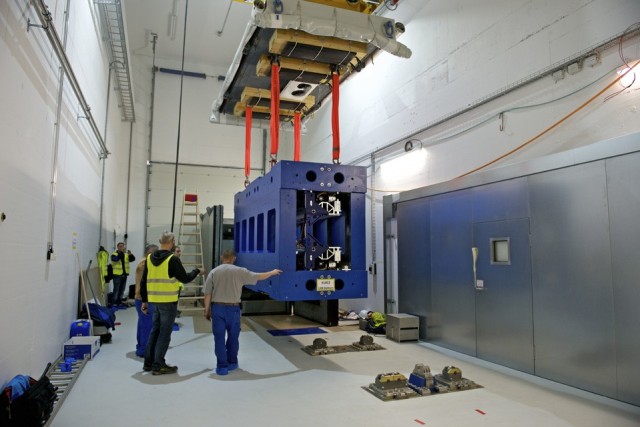May 25 2015
The first undulator frames have arrived at the SwissFEL building. They will take around six months to assemble, after which the finished undulators will be taken to the SwissFEL accelerator tunnel for installation.
 The four-metre-long, roughly 16-ton undulator frame being unloaded. Photo: Markus Fischer/PSI
The four-metre-long, roughly 16-ton undulator frame being unloaded. Photo: Markus Fischer/PSI
The sun hadn’t even risen when the special transporter turned into the building’s driveway. Due to its delicate cargo, the delivery was only possible at night as the journey needed to be quiet and at as constant a speed as possible. Now the transport container has had the chance to acclimatise and the time has come: the team opens it up and unloads the four-metre-long, sixteen-ton undulator frame.
Early-morning departure
In April the first two of twelve undulator frames manufactured by the company MDC Max Daetwyler AG arrived at the building for the x-ray free-electron laser SwissFEL, PSI’s new large-scale facility currently under construction in Würenlingen Forest.
Nothing was left to chance during the transportation. The route was inspected closely beforehand and subjected to a critical examination: “We especially had to be careful when crossing railway lines,” says Thomas Schmidt, Head of Undulator Development at PSI, who supervised the transportation, which set off for PSI from Ursenbach in the early hours of the morning.
Arrival in a welcoming environment
However, the cargo isn’t just sensitive to vibrations. In the undulators, all the x-ray light will be produced in laser quality in the finished facility, which will afford new insights into structures and processes. This is achieved by sending electrons that have been accelerated to a high energy level on a slalom path through a special magnet setup. For each undulator, 1,060 finely adjusted magnets are arranged in two rows. The undulator frames already come with a control system for the magnets, which regulates the gap between the series of magnets. This gap can then be varied between three and five millimetres when final in operation.
The undulators are now being assembled and optimised magnetically in the SwissFEL building. The high precision of the undulator components required for a smooth operation does not allow for any change to the materials that the undulators are composed of; the tiniest of temperature fluctuations would already be sufficient. Consequently, the safety entrances and the rooms prepared for the complete assembly are already at the eventual operating temperature of 24 degrees Celsius. The transport container with the undulator frame are being given time to become acclimatised before the container is finally opened. “This can take between half an hour and several hours, depending on the outside temperature,” explains Johan Wickström, who coordinates the transportation of the undulator frames to PSI and, like Thomas Schmidt, is on site the whole time to actively support the transport team.
Floating into its final position
While the container and the undulator frame is attached to the crane equipment and unloaded, the surroundings are constantly swept, mopped and hoovered. For the transportation into its final resting place in the assembly hall, the team uses an air-cushion vehicle that was developed and constructed especially for the installation of the undulators. The air-cushion vehicle is almost as sensitive as the undulators themselves: even small metal shavings or cable ties can damage the cushions. The undulator floats on a thin film of air and can thus be moved virtually friction-free. For the transportation to go smoothly, the floor needs to be levelled to an accuracy of four millimetres for the entire length of the undulator. This is because it is virtually impossible to control the undulator once it starts sliding.
A brief moment of panic – the ventilation isn’t working. Fortunately, the conditions are comparatively more relaxed during the delivery and initial assembly work. The temperature can deviate by up to two degrees Celsius from the eventual operating temperature. To enter the assembly hall, it is sufficient to wipe your dusty street shoes on a special adhesive mat. Once the magnets have been fully assembled, however, you are only allowed to enter the specially prepared room via a dirt lock. The final piece is fine-tuned exactly to the conditions in the beam channel, where there is a temperature tolerance of only plus/minus 0.1 degrees Celsius.
Into the accelerator tunnel
From now on, the undulator frames will be delivered to the SwissFEL building roughly once a month. The assembly of several undulators in parallel will take around six months to complete, after which the finished undulators will be taken into the accelerator tunnel of PSI’s new large-scale facility. The installation of the facility components is due to get underway mid-year with the integration of the electron source, where all the electrons will be generated. They will then by accelerated to a high energy level in a linear accelerator and in the undulators to emit the x-ray light. The installation work in the accelerator tunnel will take around eighteen months in all.
An undulator frame’s journey from Ursenbach to the assembly hall lasts round twelve hours, after which it’s bedtime for Thomas Schmidt and Johan Wickström. Despite all the nocturnal exertions, however, they wouldn’t miss it for the world: “A transportation like that is a very special experience – it’s nice to see all the painstaking preparations bear fruit and everything work out perfectly.”
Text: Paul Scherrer Institute/Martina Gröschl
Source: http://www.psi.ch/